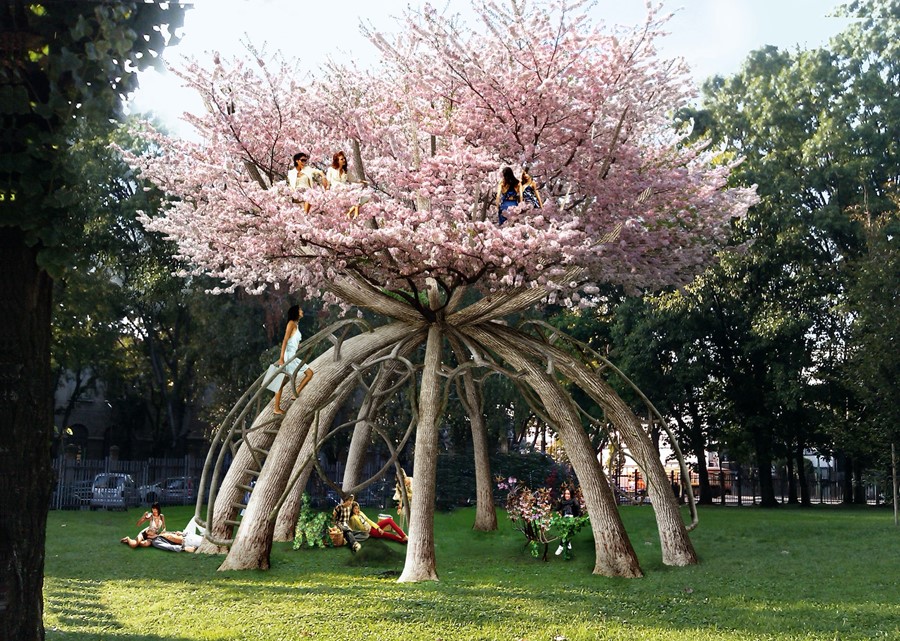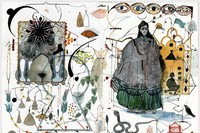Members of artist collective and publication The Earth Issue talk us through how their new publication is a hopeful reimagining of a new tomorrow
The Earth Issue’s most recent print publication posits ‘A Dream of Tomorrow’. The collective of artists, founded by Elena Cremona, produces issues of The Earth Issue magazine as well as existing as a platform for creatives who draw attention to climate change in their work, and ‘A Dream of Tomorrow’ marks its fourth issue. The magazine spotlights the work of artists and designers that incorporate environmentalism into their creativity in various ways. “‘A Dream of Tomorrow’ explores the work of 15 environmentalist artists, designers and writers around the world, each engaged in the critical, yet hopeful, exercise of ‘reimagining the future’,” explains Maela Ohana, founder and editor in chief of The Earth Issue. “Whether it be laying plans for a green city of tomorrow, planting seeds for a future generation, seeking inspiration from the slow, resilient logic of nature, or designing wearable homes for an imagined apocalypse, the projects brought together in this issue balance a sense of malaise with the present state of affairs with hopeful ‘solutions’ from within the world of the creative arts.”
‘A Dream of Tomorrow’ intends to offer solidarity, hope and inspiration following recent years that have been defined by crises: political, health, environmental, cultural, ecological and economic. This new issue arrives in the midst of two such global events: the ongoing Covid-19 pandemic and Black Lives Matter movement (The Earth Issue formulated a direct response to the latter, establishing the Freedom Fundraiser to support US and UK racial justice charities). “In a time like this, when dealing with a health and economic crisis of global proportion, it is increasingly important to bridge environmental activism and social activism in our imagined visions of the future,” says Ohana. “2020 has proved to us that we cannot delay this work any further – we must come together with our near or extended communities to design new sustainable and compassionate models for the planet and all the living networks that occupy it.” To this end, as well as artists and designers, ‘A Dream of Tomorrow’ highlights a number of BIPOC-owned fashion and accessory brands, and a selection of resources to allow readers to continue learning and helping beyond the printed publication. Here, members of The Earth Issue’s editorial team – Ohana, Cremona, and fashion and lifestyle editor Isabelle Landicho – share what it was like putting a magazine together during a pandemic, why an intersectional approach is vital now, and insights into what can be found in ‘A Dream of Tomorrow’.

“We selected our participating artists shortly before the Covid-19 pandemic began. For the first few months of lockdown we put a pause on the project – to be honest, it felt futile and frivolous to be working on an environmentalist magazine while the world was in such an acute state of human emergency. Then came the Black Lives Matter protests, and we shifted our attention to urgent measures of bail fund support with our Freedom Fundraiser. When we finally circled back to editing this issue, we were, in a sense, approaching it with new eyes. We were all actively thinking and talking about the interconnectedness of environmental and human crises, as well as the role of environmental activism in addressing community issues during a time of disaster. A good example is how farms and agricultural collectives have played a role in strengthening food security in cities during this pandemic, through providing access to public gardening spaces, educational initiatives, distributing resources, and creating equitable, sustainable food systems. Interestingly, all the stories we had selected for this issue, in one way or another, fit in perfectly with this line of thinking. Each of the 15 contributors address, in their own ways, the social and environmental anxieties of our day and age, while remaining constructive, creative and brave enough to imagine a new dawn.
“This issue, compared to last year’s ‘Manifesto’, adopts a much more intersectional approach to environmentalism – meaning that we considered human communities not only as active agents in the anthropocene but also as casualties of its ensuing harms. It is impossible to talk about environmentalism without also addressing how politics, economics, and structures of inequity make it such that some humans are disproportionately affected by resource scarcity or environmental displacement.

“The stories in this issue range from sculptural studio work prioritising gentle, localised production methods to large-scale design of green public spaces. ‘A Dream of Tomorrow’ contains surrealist plans for crisis-care, environmentalist art incorporating digital media and scientific studies, architectural projects offering resilient building processes, artist notes on covid and social justice, and a list of digital and IRL resources to aid our readership’s research into the world of sustainability and social justice in the visual arts. A notable story as an example would be Mary Mattingly’s Wearable Homes project, also featured on the cover of this issue. In response to the crisis and subsequent community healing after 9/11 in New York, Mattingly designed garments for survival in an apocalyptic world, merging design, performance art, public art and photography. Eerily relatable in 2020, Mattingly’s project draws attention to our natural tendency to rally together in a time of need, and to co-participate in each others’ healing process.
“It’s a common misconception that ethical, sustainable or even organic cotton all mean the same thing. The [brands owned by BIPOC] featured [in this issue] are environmentally gentle in different ways; some specialise in pre-loved fashion, some operate in small, slow batches and some create and sustain jobs in indigenous communities. We made sure to include as comprehensive a list as possible with help from our friends at What’s Your Legacy. Our resource includes fashion apparel, footwear and accessories brands owned by BIPOC around the world. A couple of favourites are AAKS, a British-Ghanaian accessory brand founded in order to introduce ‘the world to weaving techniques by the women of Ghana while also creating and igniting sustainable jobs in Africa’, and Sami Miro Vintage, an LA-made and -based ‘eco-conscious clothing line specialising in sourcing and reconstructing curated vintage garments’.”
The Earth Issue: A Dream of Tomorrow is available to pre-order now.






